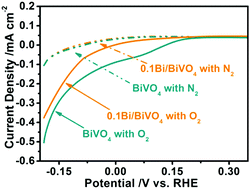当前位置:
X-MOL 学术
›
Mater. Chem. Front.
›
论文详情
Our official English website, www.x-mol.net, welcomes your feedback! (Note: you will need to create a separate account there.)
Non-noble-metal bismuth nanoparticle-decorated bismuth vanadate nanoarray photoanode for efficient water splitting†
Materials Chemistry Frontiers ( IF 7 ) Pub Date : 2018-07-04 00:00:00 , DOI: 10.1039/c8qm00239h Ba-Ri Wulan 1, 2, 3, 4, 5 , Sha-Sha Yi 1, 2, 3, 4, 5 , Si-Jia Li 1, 2, 3, 4, 5 , Yan-Xin Duan 1, 2, 3, 4, 5 , Jun-Min Yan 1, 2, 3, 4, 5 , Xin-Bo Zhang 1, 2, 3, 4, 5 , Qing Jiang 1, 2, 3, 4, 5
Materials Chemistry Frontiers ( IF 7 ) Pub Date : 2018-07-04 00:00:00 , DOI: 10.1039/c8qm00239h Ba-Ri Wulan 1, 2, 3, 4, 5 , Sha-Sha Yi 1, 2, 3, 4, 5 , Si-Jia Li 1, 2, 3, 4, 5 , Yan-Xin Duan 1, 2, 3, 4, 5 , Jun-Min Yan 1, 2, 3, 4, 5 , Xin-Bo Zhang 1, 2, 3, 4, 5 , Qing Jiang 1, 2, 3, 4, 5
Affiliation

|
Sunlight-driven photoelectrochemical (PEC) water splitting using earth-abundant semiconductor-based materials offers one promising strategy to produce attainable and sustainable carbon free energy. Herein, we demonstrate for the first time that a heterojunction nanostructure of a Bi/BiVO4 photoanode is fabricated by directly coupling semimetal Bi nanoparticles to BiVO4 nanoarrays, showing excellent water oxidation performance. The as-obtained photoanode exhibits a remarkable photocurrent density of 1.96 mA cm−2 at 1.23 V versus a reversible hydrogen electrode (vs. RHE) under AM 1.5G (100 mW cm−2) irradiation, which is approximately 2-fold higher than that of the pristine BiVO4. Based on the detailed analyses of J–V, i–t, M–S and EIS plots, the reason for the high photocurrent density of Bi/BiVO4 can be attributed to the improved charge separation efficiency, the enhanced hole injection efficiency and the suppressed back reaction of water oxidation.
中文翻译:

非贵金属铋纳米粒子修饰的钒酸铋纳米阵列光电阳极可实现有效的水分解†
使用地球上丰富的基于半导体的材料进行阳光驱动的光电化学(PEC)水分解提供了一种产生可实现且可持续的无碳能源的有前途的策略。在这里,我们首次证明了Bi / BiVO 4光电阳极的异质结纳米结构是通过将半金属Bi纳米颗粒直接耦合到BiVO 4纳米阵列而制成的,显示出优异的水氧化性能。与在AM 1.5G(100 mW cm -2)照射下的可逆氢电极(vs. RHE)相比,如此获得的光阳极在1.23 V电压下表现出1.96 mA cm -2的显着光电流密度,比可逆氢电极高约2倍。原始BiVO的4。根据J – V, i – t,M–S和EIS曲线的详细分析,Bi / BiVO 4的高光电流密度的原因可归因于电荷分离效率的提高,空穴注入效率的提高和电子注入效率的提高。抑制水氧化的逆反应。
更新日期:2018-07-04
中文翻译:

非贵金属铋纳米粒子修饰的钒酸铋纳米阵列光电阳极可实现有效的水分解†
使用地球上丰富的基于半导体的材料进行阳光驱动的光电化学(PEC)水分解提供了一种产生可实现且可持续的无碳能源的有前途的策略。在这里,我们首次证明了Bi / BiVO 4光电阳极的异质结纳米结构是通过将半金属Bi纳米颗粒直接耦合到BiVO 4纳米阵列而制成的,显示出优异的水氧化性能。与在AM 1.5G(100 mW cm -2)照射下的可逆氢电极(vs. RHE)相比,如此获得的光阳极在1.23 V电压下表现出1.96 mA cm -2的显着光电流密度,比可逆氢电极高约2倍。原始BiVO的4。根据J – V, i – t,M–S和EIS曲线的详细分析,Bi / BiVO 4的高光电流密度的原因可归因于电荷分离效率的提高,空穴注入效率的提高和电子注入效率的提高。抑制水氧化的逆反应。



























 京公网安备 11010802027423号
京公网安备 11010802027423号